You probably know the saying “Knowledge is power”. This is also true in fundraising, maybe even more so. In many of our articles we try to make the point that doing great donor research is key before you start with the networking and actual applying. We have told you about great ways to research and find donors, how to setup a database, and how to actually connect. But there is one more way to actually gather very specific and important information about potential supporters that we have not yet touched upon: transparency data. So, in this article we want to talk about it in more depth to make sure you will be able to take advantage of transparency data for fundraising in the future.
What is transparency data in development?
Surely you have heard the word transparency a lot if you work in development. Transparency is key for so many things. If you are an NGO, transparency in your own spending is important for your supporters and beneficiaries to understand how you work and spend your funds. Transparency in your own government is important to create trust in its institutions and decisions. The more you know about something, the more you can develop confidence in its manifestations.
Well, the same goes for development. When we talk about transparency data in development, we mean information about spending and investing in this sector. Governments, donors, foundations and NGOs should share the data about where their funding comes from and where it goes in the name of transparency. This does not only give more confidence for potential donors; it also makes it easier to see impact and changes due to this spending and to hold all actors accountable. That is why the monitoring, assessment, reporting and promoting of the provision of resources that support sustainable development is at the top of the global agenda.
How can you use it?
The more you know about how governments, foundations and bilateral spend their money on development projects, the more confidence you can gain in the validity of their giving. At the same time, this data also tells you a lot about the priorities of the donors, where money was spent in the last years and where it might go in the future. But there are a couple of other benefits of using transparency data in your research process. Here are just a couple of examples of the areas where you could use this information.
- Planning of projects that align with donor priorities
- Understanding funding in your area of work
- Finding potential donors to add to your donor research table
- Identifying trends that can be useful for your future work
- Holding your government or other major donors accountable to their promises
If you know what priorities a donor has, you can tailor your proposals and your projects towards those priorities if you want to work with them. While you should of course not change your entire program just to appease a donor, it makes sense to make sure you have overlap if your mission is the same and it fits within your project. The more you know about a donor, the easier it is to really craft a project that would be a perfect and natural fit. That is why transparency data about past projects and spending can be the perfect guideline you need to design your project.
Transparency data can also help you to keep your own government or bigger players accountable. If your government has committed to spending money in a specific sector, transparency data can tell you if they are really doing that. If they have to share which NGOs they are working with, you can understand where the money is flowing to and if there are any issues. It gives you insight into processes that have happened in the dark in the past.
Where can you find it?
So, this all sounds great, but where can you actually find this kind of data about transparency? More and more governments, foundations and NGOs are committed to sharing this data, and there are some sources that provide it. One of the initiatives providing real-time data is IATI (International Aid Transparency Initiative), but also the OECD provides this information, even though only for prior periods of time.
Have you ever worked with transparency data? Would you like to learn more about it? We are currently running a survey and would love to understand your needs better.
Please support us in taking this short survey.




So good
So good and nice
Dear Mengalle:
I am glad you found this article helpful!